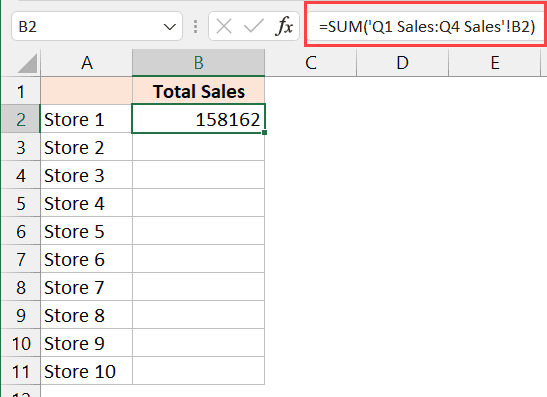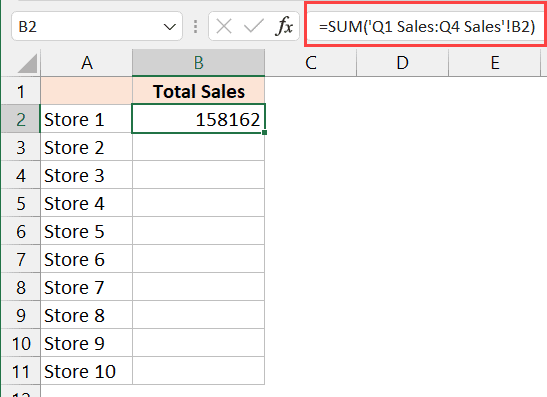Excel Magic: Summing Across Sheets Easily

Imagine juggling spreadsheets filled with data, each more intricate than the last. You're tasked with the seemingly daunting job of summing numbers that scatter across various sheets. Sounds tedious, right? Let's dispel that myth by diving into Excel's world of cross-sheet functionality, making it not just manageable but also remarkably efficient.
Understanding Cross-Sheet Operations in Excel

Excel, at its core, is designed for data management across multiple dimensions. Summing data across sheets might seem like a complex task, but with the right tools, it's straightforward:
- Structured References: Excel's capacity to reference cells across different worksheets allows for dynamic and flexible data summation.
- Consolidation Functions: Functions like SUMIF, SUMIFS, and VLOOKUP help in aggregating data with specific criteria across sheets.
Let's proceed with the practical steps to sum across sheets effortlessly.
Step-by-Step Guide to Sum Across Sheets

1. Setting Up Your Workbook

First, ensure your workbook is organized:
- Ensure each sheet contains data you want to sum.
- Sheet names should be clear and descriptive, such as “Jan,” “Feb,” etc., for monthly data.
2. Using the SUM Function Across Sheets

The simplest way to sum values across sheets is using the =SUM() function with sheet references:
Example: If you want to sum cell A1 from sheets named “Jan,” “Feb,” and “Mar,” your formula would look like:
=SUM(‘Jan:Mar’!A1)💡 Note: Ensure the sheet names are exact matches, and if there's a space in the name, enclose it in single quotes, e.g., 'Monthly Report 2023'!A1.
3. Advanced Cross-Sheet Summation

For more complex scenarios, you might need conditional summation:
- SUMIF: Adds numbers that meet a single criterion.
- SUMIFS: Aggregates numbers based on multiple criteria.
Here’s how you can apply these functions:
=SUMIFS(Sheet1!B:B, Sheet1!A:A, "Product A", Sheet1!C:C, ">100")4. Leveraging Excel Tables

Tables in Excel streamline data management:
- Convert ranges into tables for dynamic summing across sheets.
- Utilize structured references with table names for cleaner formulas.
5. Automation with Macros

Macros can automate repetitive tasks:
- Create a macro to dynamically sum data across sheets.
- Automate data consolidation for periodic reports.
Here’s a basic macro to sum data across sheets:
Sub SumAcrossSheets()
Dim ws As Worksheet, rng As Range
Dim totalSum As Double
totalSum = 0
For Each ws In ThisWorkbook.Worksheets
If ws.Name <> "Summary" Then
Set rng = ws.Range("A1")
totalSum = totalSum + rng.Value
End If
Next ws
MsgBox "The total sum across sheets is: " & totalSum
End Sub💡 Note: This macro assumes you have a "Summary" sheet where you don't want to include values. Adjust as necessary.
Best Practices for Efficient Cross-Sheet Summation

To ensure accuracy and efficiency:
- Keep Data Clean: Regularly review for errors, avoid duplicates, and maintain consistent formatting.
- Use Named Ranges: Simplify references and reduce errors by naming ranges or cells.
- Maintain Sheet Structure: Consistent layout across sheets eases formula application.
Here’s a table to summarize the key practices:
| Practice | Description |
|---|---|
| Data Consistency | Ensure data integrity across all sheets. |
| Named Ranges | Assign names to simplify references and formula maintenance. |
| Structured Layout | Maintain similar data structures across sheets. |
| Regular Audits | Check formulas and data for accuracy periodically. |

To wrap things up, Excel's magic lies in its ability to make complex tasks, like summing data across sheets, an intuitive process. With the right techniques, you can streamline your workflow, save time, and minimize errors. Whether through basic formulas, advanced functions, or automation, Excel offers an array of tools to boost productivity and data analysis capabilities.
How can I sum cells across sheets with different layouts?

+
Use INDIRECT() for dynamic referencing, though it can be complex. Ensure all sheets have the same key cell location, or consider restructuring your sheets for uniform data placement.
What if my sheet names contain special characters?

+
Enclose the sheet name in single quotes to handle special characters or spaces, e.g., ‘Sheet Name!A1’.
Can I automate the creation of SUM formulas?

+
Yes, with VBA macros, you can automate the generation of formulas, but be mindful of the complexity and potential for errors if not maintained properly.



